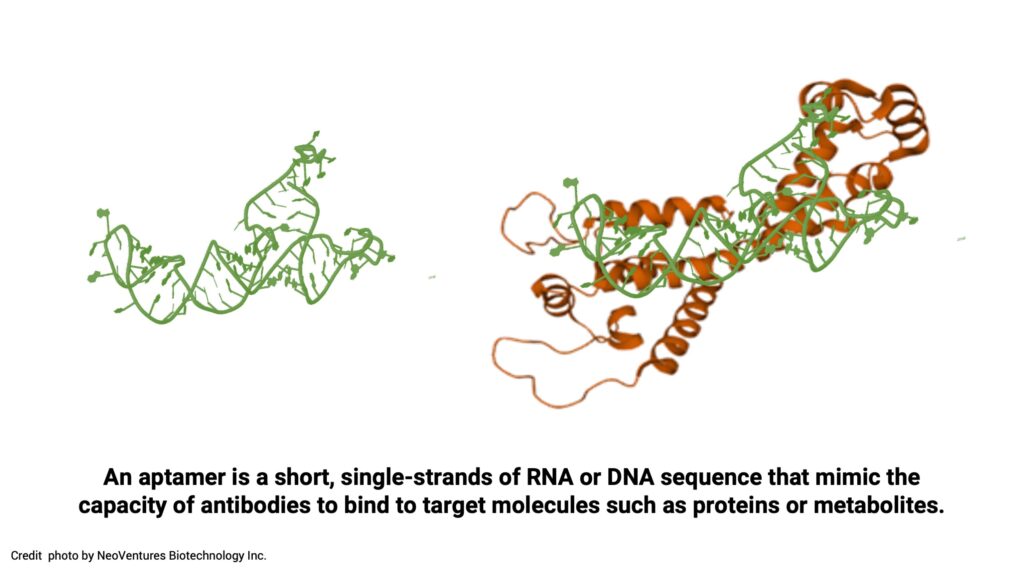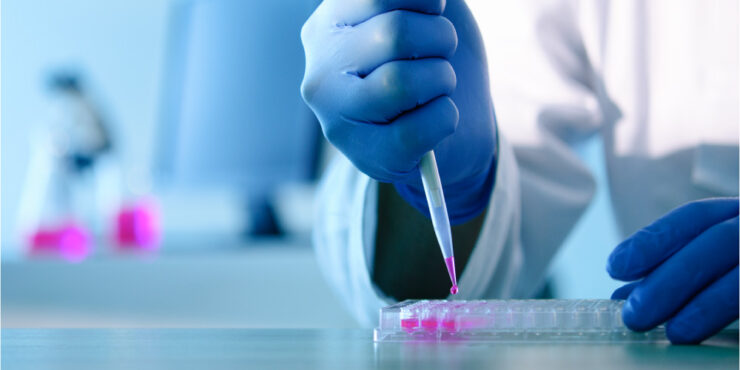
As president, a co-founder and CEO of closely-held NeoVentures Biotechnology, Gregory Penner, Ph.D., took a different route developing aptamers for healthcare solutions. His training was in quantitative genetics of crop breeding and included stints with Agriculture Canada and Monsanto in St. Louis. Dr. Penner attributes the success that NeoVentures has had to his commitment to mathematically modeling problems and experience with the analysis of deep data. In this interview with BioTuesdays.com, Dr. Penner explains the utility of aptamers and development of commercial-ready aptamers.
What is an aptamer?
They were invented in the late 1980s and are short, single-strands of RNA or DNA sequences that mimic the capacity of antibodies to bind specifically to target molecules, such as proteins or metabolites. They are single-stranded and as such, they have the capacity to fold themselves into unique shapes based on their sequence. Each shape has the capacity to bind other molecules based on charge interactions. Aptamers are synthesized chemically; they are not derived from living matter.

Let’s begin with a brief history of NeoVentures.
In 2001, I met Ximena Vedoya, who worked in regulatory affairs for Monsanto in Latin America. We decided to leave Monsanto and start our own company in Canada, creating NeoVentures Biotechnology in June of 2002. This means that we have been working on aptamers for 18 years. We were the first company to develop an aptamer-based diagnostic for mycotoxins in 2009. It became apparent that diagnostics for the grain industry had significant commercial limitations. We realized that we were in a global leadership position in terms of the commercialization of aptamers, so we decided to pivot into a fee-for-service business model to develop aptamers for third parties, in particular in health care. NeoVentures has become a global leader in aptamer development and applications, pioneering improvements to the consistency of aptamer discovery, the validity of binding assays and the performance of aptamers in commercial applications.
In 2015, we spun off a separate company, NeoNeuro, in Paris to explore aptamer applications for Alzheimer’s disease. This has led to the development of an agnostic platform, Aptamarkers, for the discovery of biomarkers for any disease. NeoNeuro is currently validated their Aptamarker diagnostic platform as a diagnostic test for brain amyloid deposition based on blood analysis in collaboration with researchers in Australia. We have eight employees in Canada and three in Paris, who bring a wide array of skills from microbiology to molecular biology and bioinformatics. In Canada, our business is focused on development of aptamers for specific opportunities identified by clients in diagnostics, therapeutics, consumer products and quality control of pharmaceutical production. In Paris, our focus is to use our Aptamarker platform to screen all of the molecules in blood simultaneously for their potential as biomarkers for complex diseases.

How would you describe your company’s focus?
We have spent the last 18 years overcoming constraints with innovative, aptamer driven solutions. We have developed state of the art selection processes for the identification of aptamers against a broad range of targets from small molecules, with our industry leading FRELEX selection platform, to selection for proteins directly in plasma, to aptamers for large structures, such as LDL particles, to techniques for in situ selection of transmembrane proteins on living cells, such as HER2 on breast cancer cells, to the differentiation of parathyroid tissue from thyroid tissue. We have had to develop novel selection strategies for a broad and diverse range of targets. Bottom line, our focus is that we solve problems for our clients using aptamer-based solutions.

What are the advantages of aptamers over antibodies in diagnosis and therapeutics?
Aptamers have similar affinities for their targets as antibodies but provide several advantages, including greater stability, greater scalability for production, low immunogenicity and the ability to target molecules with low antigenicity. Like antibodies, aptamers have a broad range of applications, serving as drugs, diagnostic and therapeutic tools, analytic reagents, and bio-imaging molecules. Another key advantage of aptamers is that they do not need cold storage for shipping, which is a significant cost savings. While cell lines for antibodies need to be constantly maintained for quality control, there is very little lot-to-lot variability with aptamers.
Why have these advantages not been realized to date?
There are several reasons. The first is that the original broad patents covering all aptamer applications have expired. This has led to a wave of products working their way towards commercialization now. Second, aptamers cannot be simply substituted for antibodies in diagnostic applications. We’ve developed innovative chemistry solutions that enable the maintenance of aptamer functionality over time. Third, many of the aptamers developed in the public domain simply do not work well enough to support commercialization.
What has NeoVentures done to overcome these constraints?
We’ve been at this a long time and we develop aptamers as a business. A publication can be based on an aptamer working once in a single assay. A commercially successful product must work under a broad range of conditions, it must work exactly the same for months after production, and it must work in relevant matrices, such as blood or saliva. We include these considerations in every part of our aptamer development process. We have also developed the capacity to understand the shape landscape of individual aptamers and to use this knowledge to make better aptamers through truncation and nucleotide substitutions.
What is the future for aptamers in diagnostics?
The immediate applications involve solutions for problems that cannot be solved by antibodies. This includes applications for the detection of small molecules in a free state, and large structures in native states. The next stage of aptamer applications will be to support diagnosis of complex diseases based on patterns of biomarkers across individuals. Ultimately, given that aptamers are easier to work with in terms of production, storage and commercialization, I can see aptamers taking over the entire diagnostic space. A platform that represents a cost saving eventually takes over any market. For aptamers, this is a tremendous opportunity as the antibody diagnostic space is valued at about $18-billion a year.
How about in therapeutics, are there real opportunities for aptamers in this space?
The key to success with aptamers in therapeutics is targeting applications that cannot be served by stimulation of immune responses. Antibodies will always do that better. We are focused on applications that inhibit immune response, such as autoimmune diseases, checkpoint inhibition in cancer, and chronic inflammation.
We’re working with partners to develop these across a range of diseases. We are also developing applications where aptamers are to be used as vectors for the targeted delivery of therapeutics into cells, to specific tissues, or through the brain blood barrier.
What can you share about your Alzheimer’s disease program?
The biggest problem with Alzheimer’s is that by the time a person develops cognitive dysfunction, it’s really too late to develop a treatment for the disease. It’s like untreatable cancer at that point. Beta amyloid accumulation in the brain leading to plaque formation starts to occur at least 20 years before cognitive dysfunction is evident. What is needed are much earlier and simpler detection methods. We’ve developed a blood-based diagnostic where we look at multiple factors simultaneously to predict brain amyloid deposition as a key risk factor for Alzheimer’s disease. Validation of this product is financed in Paris by the Alzheimer’s Drug Discovery Foundation.
Do you see aptamers simply replacing antibodies in health care applications, or do you have a grander vision?
Traditional blood tests that deliver a binary result work well for simple diseases and infections but are not effective for more complex issues, like autoimmune diseases, Alzheimer’s and chronic pain, where there are no effective diagnoses from a blood sample. What we need to develop are effective diagnoses before we develop effective treatments. What we’re doing at NeoNeuro with Aptamarkers leads the way towards a mapping of the shape of an individual’s wellness so we can develop an individual ownership approach to health care.
• • • • •
To connect with Azura Ophthalmics or any of the other companies featured on BioTuesdays, send us an email at [email protected].






